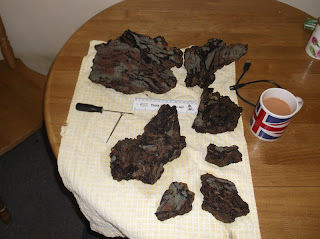I today found more organic looking fossil material in the Mercia mudstone outcrop at Stainsby beck Thornaby on tees. The image above shows the piece buried into the Mercia mudstone just below the tool.

More as i learn more !
My good friends Andy Cooper and Roger Curry both spotted parts of these pieces dug from the Triassic Mercia mudstone outcrop at Stainsby beck Thornaby. That hinted at them being some kind of burrow system or tuffa but both spotted what looks to possibly be a section of caddis fly lavia ( of some sort ) casing.
The image above shows the new find before i removed the Triassic mudstone, it was buried in.
The image above and following images show the cleaned up pieces.

The image above shows one of many tubular pieces that resemble caddis fly casings
The images above and below i hope show what i believe could be the yellow coloured fossil larvae?


















































